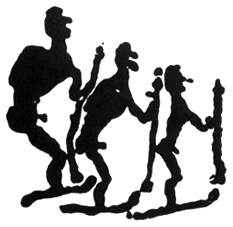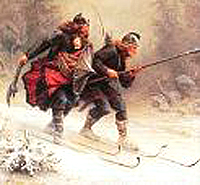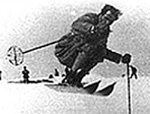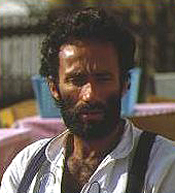 history
history history
historyIn the beginning, there was a vast expanse of snow-covered terrain, and someone with a desire to go somewhere.

Detail from a Russian cave drawing,
circa 5,000 BC,
appears to show hunters on crude ski-like objects;
improvements such as Gore-Tex and polypropylene
have greatly enhanced genital warmth in the modern era
Skiing began as simply a means of travel in cold environments, a necessary skill for hunters and warriors in what is now Scandinavia and Russia. Examples of simple wooden skis with leather toe bindings have been recovered from bogs in Norway, some dating back as many as 4,500 years, and numerous much older cave drawings and stone etchings have been found that depict humans on ski-like implements chasing game or preparing for war.

Birkebeiner soldiers carry baby Haakon to safety
Precisely when skiing began to lose its strictly utilitarian theme isn't clear - though there are written Icelandic records from around 1,000 AD that refer to the skiing skill of Viking king Harald Hadrade, as well as to ski races and betting on their outcome. In 1206 AD, Norwegian soldiers on skis carried King Haakon III Sverresson's baby (later to become King Haakon Haakonson) to safety over the mountains to Trondheim during a time of civil war, a feat that is still commemorated annually during the Birkebeiner cross country race, in which contestants must carry a 3.5 kg pack to simulate the weight of the young prince.
Credit for the invention of modern ski technique goes to farmers around the Telemark region of Norway, in particular Sondre Norheim, a gifted athlete and potato farmer from the area.

Norwegian petroglyph appears to show early use of super stable 600cm downhill skis
While he may or may not have actually invented the telemark turn, Norheim is credited with the improvements that allowed controlled turns and jumps to be incorporated into ski technique. Around 1850, he and his fellow Telemarkers began using a heel strap made of birch root strands that attached to the toe strap of the binding, preventing the heel from slipping out and allowing the practitioners to execute both the "Telemark" turn and the "Christiana" (parallel or hockey-stop) turn. The combination of new equipment and technique allowed skiers to change direction and stop with unprecedented accuracy, not to mention huck big air.
Skiing as a sport and mode of transportation rose to become wildly popular in Norway, culminating in expeditions across Greenland by Fridtjof Nansen in 1888, and to the South Pole by Roald Amundsen in 1911. Norwegians spread the sport to other shores by way of emigration in the late 1800's, with scores of skilled skiers moving to America and elsewhere, among them Norheim and Jon Tostensen Rue (later to be known as John "Snowshoe" Thompson, the skiing mailman of the Sierras).
On the Continent, skiing took on a much more luxurious tone, with hotels and resorts attempting to use the sport as a way to attract well-heeled customers during the winter months. Both the Telemark turn and the Christiana turn required rather advanced skill levels to be effective, but retired Austrian schoolteacher Mathias Zdarsky's invention of the "stem" (snowplow) technique in the 1890's enabled a new flock of inexperienced city-dwellers to take to the mountains on skis and descend more or less safely.

Austrian legend Hannes Schneider rips it up
Johannes "Hannes" Schneider, founder of the Arlberg School, further refined the "stem" technique, incorporating three levels of standardized instruction under the name of the Arlberg Technique (snowplow stem, stem turn, stem christy) that exist in similar form to this day. His ski school employed most of the best skiers and racers in Europe during the 1930's until they began leaving to escape the tyranny of Nazi Germany - famous names such as Toni Matt (Mt. Cranmore), Otto Lang (Mt. Rainier, Mt. Baker, Mt. Hood), Friedl Pfeifer (Sun Valley, Aspen) and Schneider himself all emigrated and helped to launch the new sport in the United States. These and other Austrians took over the management of new ski resorts all over the U.S. and Canada, and fired the imagination of the American public.
Until this time, of course, almost all skiing was ski touring - the few lifts available (surface lifts appeared first in Europe in 1908, followed by cable cars in Chamonix in 1927 and Engleberg, Switzerland in 1928) were considered luxuries by most skiers, and they ascended the tried-and-true way with skins and boots. The first rope tow appeared in North America in 1934 in Woodstock Vermont, and the first chairlift (Sun Valley) in 1936, which set the tone for mass entry into the sport. Most Americans concentrated on the thrills of the descent, but a core of European émigrés and American-born climbers continued to ascend their chosen slopes under their own power.
In Europe the division between alpine skiing using lifts or trains and ski mountaineering became more marked, with many people eschewing the use of mechanical ascent and concentrating solely on self propulsion. In 1897 Wilhelm Paulke completed the first true alpine traverse in Europe, crossing the Bernese Oberland on skis. The first successful navigation of the Haute Route from Chamonix to Zermatt was completed in January of 1903 by Dr. Payot, Joseph Couttet, Joseph Ravanel, and Alfred Simond and the search for skiable terrain was on.
The modern age of European steep skiing perhaps began with French Olympic hero Émile Allais' ski descents of l'Aiguille d'Argentiére (with André Tournier) and the north face of the Dôme du Goûter (with Etienne Livacic) in the winter of 1940-41. In 1951, American Bill Dunaway and French guide Lionell Terray shocked the world by making the first ski descent of Mt. Blanc. Swiss powerhouse Sylvain Saudan threw fuel on the fire in 1964 with first descents of the Couloir Whymper on l'Aiguille Verte and the Couloir Marinelli on Monterosa. Patrick Vallençant made history with a descent of the 60 degree slopes of Yerupaja, Peru in 1979, and Jean-Marc Bovin skied the similarly difficult Matterhorn East Face in the same year. Vallençant's friend and fellow guide Anselme Baud, also a pivotal figure in the early "extreme" movement, introduced a system of grading descent difficulty in 1977, called the "S" System, with seven gradations based on steepness and snow conditions.

Famed Chamonix guide and extreme ski pioneer Patrick Vallençant
On the North American continent, Sigurd Hall and Dwight Watson skied from the summit of Glacier Peak in 1938, while Seattle climbing legend Fred Beckey and friends skied Ruth Mountain in 1940 and completed a traverse from Mt. Waddington (Canada) to the Tiedemann Glacier in the summer of 1942. Kermit Bengston, Dave Roberts, Cliff Schmidtke and Charles Welsh made the first ski descent of Mt. Rainier via the Emmons Glacier in 1948. Hans Gmoser began to pioneer routes in the Canadian Rockies around 1960 as well, traversing from Kickinghorse Pass to the Columbia Icefield and later writing about the trip in the Canadian Alpine Journal. 1971 saw the first ski descents of Mt. Hood's Wy'east Face (Sylvain Saudan) and Wyoming's Grand Teton (Bill Briggs). Chris Landry made the first ski descent of Liberty Ridge on Mt. Rainier in 1980, just prior to the eruption of Mt. St. Helens, and witnessed several huge avalanches on Rainier during his trip, possibly due to seismic disturbances emanating from the more southern volcano.
In more recent times, ski mountaineers have ranged higher and further afield, with Pierre Tardivel skiing from about 250 ft. below the summit of Mt. Everest in 1992, and Hans Kammerlander skiing from the summit with a small amount of downclimbing in 1996. The first continuous ski descent of Everest was made in 2000 by Davo Karnicar of Slovenia on special 168cm Elan skis. Armond Dubuque, Doug Ingersoll, Andrew McLean and Carl Skoog made the first ski descent of the Mowich Face on Mt. Rainier via the Edmunds Headwall in 1997.
In the Pacific Northwest, the late Ben Manfredi and his posse, including Josh and Jason Hummel and Sky Sjue, have been responsible for a number of first descents in the North Cascades within the past five years, on mountains such as Maude, Fury, Buckner and Luna Peak. North Bend-based guide Martin Volken and friends have also laid down first tracks on a number of Washington peaks in the past decade, while the Skoog brothers (Lowell and Carl) have pioneered a handful of breathtaking traverses in the northern part of the state.
The advent of lighter gear, shorter and wider skis with skill-enhancing shapes, and lightweight weatherproof fabrics have served to push ski touring to the forefront of the sport in recent years. Combined with the drastic overcrowding of ski resorts and the rabid competition for untracked turns, backcountry "style" (randonnée bindings, pack with shovel handle showing, duct tape on pants) is becoming commonplace in lift lines at resorts like Jackson Hole, Alta, and Alpental, and a growing number of these people actually use the equipment for its intended purpose. Travelers on the Haute Route out of Chamonix are lucky to see fewer than 50 fellow skiers during a day of touring, while local skiers sessioning popular routes on Rainier or Adams may find dozens of fellow enthusiasts in their skintrack on a nice weekend day.
Newcomers to the sport of randonnée skiing should take heart in its recent boom in popularity - more participants will only mean greater availability of quality gear at better prices and with better service from shops, and it's still a simple matter to avoid the crowds if that is your intention - all it takes is a few more minutes of hiking!
For an extremely detailed timeline of skiing and mountaineering history, see Lou Dawson's excellent site here; for more detailed information on ski mountaineering in the Pacific Northwest, Lowell Skoog's site is a must-visit.
© 2025 Gregory C. Louie